On the Potential Optical Signature of Convective Turbulence over the West Florida Shelf
Abstract
1. Introduction
2. Materials and Methods
2.1. Satellite Data
2.2. COAMPS and Buoy Data
3. Results
3.1. Meteorological and Physical Oceanographic Setting
3.2. Coincident Satellite True Color
3.3. Merger of COAMPS Results with Satellite Images
3.4. High-Temporal Resolution GOES-R ABI Data
3.5. Examination of Level-3 Inversion Products
4. Discussion
5. Conclusions
Supplementary Materials
Author Contributions
Funding
Institutional Review Board Statement
Informed Consent Statement
Data Availability Statement
Acknowledgments
Conflicts of Interest
References
- Nowlin, W.D.; Parker, C.A. Effects of a Cold-Air Outbreak on Shelf Waters of the Gulf of Mexico. J. Phys. Oceanogr. 1974, 4, 467–486. [Google Scholar] [CrossRef]
- Villanueva, E.E.; Mendoza, V.M.; Adem, J. Sea surface temperature and mixed layer depth changes due to cold-air outbreak in the Gulf of Mexico. Atmosfera 2010, 23, 325–346. [Google Scholar]
- Schroeder, W.W.; Huh, O.K.; Rouse, L.J.; Wiseman, W.J. Satellite Observations of the Circulation East of the Mississippi Delta: Cold-Air Outbreak Conditions. Remote Sens. Environ. 1985, 18, 49–58. [Google Scholar] [CrossRef]
- Dagg, M.J. Physical and biological responses to the passage of a winter storm in the coastal and inner shelf waters of the northern Gulf of Mexico. Cont. Shelf Res. 1988, 8, 167–178. [Google Scholar] [CrossRef]
- Zavala-Hidalgo, J.; Romero-Centeno, R.; Mateos-Jasso, A.; Morey, S.L.; Martinez-Lopez, B. The response of the Gulf of Mexico to wind and heat flux forcing: What has been learned in recent years? Atmosfera 2014, 27, 317–334. [Google Scholar] [CrossRef]
- Passalacqua, G.A.; Sheinbaum, J.; Martinez, J.A. Sea surface temperature influence on a winter cold front position and propagation: Air-sea interactions of the ‘Nortes’ winds in the Gulf of Mexico. Atmos. Sci. Lett. 2016, 17, 302–307. [Google Scholar] [CrossRef]
- DiMego, G.J.; Bosart, L.F.; Endersen, G.W. An examination of the frequency and mean conditions surrounding frontal incursions into the Gulf of Mexico and Caribbean Sea. Mon. Weather Rev. 1976, 104, 709–718. [Google Scholar] [CrossRef]
- Pérez, E.P.; Magaña, V.; Caetano, E.; Kusunoki, S. Cold surge activity over the Gulf of Mexico in a warmer climate. Front. Earth Sci. 2014, 2, 19. [Google Scholar] [CrossRef]
- Hunniford, R. The Impact of Marine Cold-Air Outbreaks on the Rate of Oceanic Heat Storage in the Gulf of Mexico. Master’s Thesis, Florida State University, Tallahassee, FL, USA, 2011. Available online: http://purl.flvc.org/fsu/fd/FSU_migr_etd-3400 (accessed on 15 October 2020).
- Huh, O.K.; Wiseman, W.J., Jr.; Rouse, L.J., Jr. Winter cycle of sea surface thermal patterns, northeastern Gulf of Mexico. J. Geophys. Res. 1978, 83, 4523–4529. [Google Scholar] [CrossRef]
- Walker, N.D.; Rouse, L.J.; Huh, O.K. Response of subtropical shallow-water environments to cold-air outbreak events: Satellite radiometry and heat flux modeling. Cont. Shelf Res. 1987, 7, 735–757. [Google Scholar] [CrossRef]
- Moum, J.; Smyth, W.D. Upper Ocean Mixing Processes. In Encyclopedia of Ocean Sciences; Steele, J.H., Ed.; Academic Press: Cambridge, MA, USA, 2001; pp. 3093–3100. [Google Scholar]
- Shay, T.J.; Gregg, M.C. Convectively driven turbulent mixing in the upper ocean. J. Phys. Oceanogr. 1986, 16, 1777–1798. [Google Scholar] [CrossRef]
- Lombardo, C.P.; Gregg, M.C. Similarity scaling of viscous and thermal dissipation in a convecting surface boundary layer. J. Geophys. Res. Ocean. 1989, 94, 6273–6284. [Google Scholar] [CrossRef]
- Zikanov, O.; Slinn, D.N.; Dhanak, M.R. Turbulent convection driven by surface cooling in shallow water. J. Fluid Mech. 2002, 464, 81–111. [Google Scholar] [CrossRef]
- Larson, E.B.; Mylroie, J.E. A review of whiting formation in the Bahamas and new models. Carbonates Evaporites 2014, 29, 337–347. [Google Scholar] [CrossRef]
- Morse, J.W.; Gledhill, D.K.; Millero, F.J. Caco3 precipitation kinetics in waters from the great Bahama bank: Implications for the relationship between bank hydrochemistry and whitings. Geochim. Cosmochim. Acta 2003, 67, 2819–2826. [Google Scholar] [CrossRef]
- Wernand, M.R.; Hommersom, A.; Van der Woerd, H.J. MERIS-based ocean colour classification with the discrete Forel-Ule scale. Ocean. Sci. 2013, 9, 477–487. [Google Scholar] [CrossRef]
- Mobley, C.D. Light and Water; Academic Press: San Diego, CA, USA, 1994; p. 595. [Google Scholar]
- Jerlov, N.G. Marine Optics, 2nd ed.; Elsevier Oceanography Series 14; Elsevier: New York, NY, USA, 1976; p. 231. [Google Scholar]
- Vandermeulen, R.A.; Mannino, A.; Craig, S.E.; Werdell, P.J. 150 shades of green: Using the full spectrum of remote sensing reflectance to elucidate color shifts in the ocean. Remote Sens. Environ. 2020, 247, 111900. [Google Scholar] [CrossRef]
- Jolliff, J.K.; Jarosz, E.; Ladner, S.; Smith, T.; Anderson, S.; Dykes, J. The Optical Signature of a Bottom Boundary Layer Ventilation Event in the Northern Gulf of Mexico’s Hypoxic Zone. Geophys. Res. Lett. 2018, 45, 8390–8398. [Google Scholar] [CrossRef]
- Jolliff, K.J.; Lewis, D.M.; Ladner, S.; Crout, L.R. Observing the Ocean Submesoscale with Enhanced-Color GOES-ABI Visible Band Data. Sensors 2019, 19, 3900. [Google Scholar] [CrossRef] [PubMed]
- Ladner, S.; Crout, R.; Lawson, A.; Martinolich, P.M.; Bowers, J.; Arnone, R.A. Validation Test Report for the Automated Optical Processing System (AOPS) Version 16. In U.S. Naval Research Laboratory Technical Memorandum; NRL/MR/7330-16-9697; United States Naval Research Laboratory: Washington, DC, USA, 2016; p. 78. [Google Scholar]
- Mobley, C.D.; Werdell, P.J.; Franz, B.A.; Ahmad, Z.; Bailey, S. Atmospheric Correction for Satellite Ocean Color Radiometry: A Tutorial and Documentation of the Algorithms Used by the NASA Ocean Biology Processing Group NASA/TM-2016-217551, GSFC-E-DAA-TN35509. Available online: https://oceancolor.gsfc.nasa.gov/docs/technical/NASA-TM-2016-217551.pdf (accessed on 22 December 2020).
- CIE. CIE 15, International Commisssioin on Illumination, Technical Report: Colorimetry, 3rd ed.; 10 CFR 430 Subpart B, App. R. 4.1.1; Carter, E.C., Ohno, Y., Pointer, M.R., Robertson, A.R., Seve, R., Schanda, J.D., Witt, K., Eds.; International Commission on Illumination: Vienna, Austria, 2004; p. 82. ISBN 3-901-906-33-9. [Google Scholar]
- Broadbent, A. Colorimetry, Methods. In Encyclopedia of Spectroscopy and Spectrometry, 3rd ed.; Lindon, J.C., Ed.; Academic Press: Cambridge, MA, USA, 2017. [Google Scholar] [CrossRef]
- Lewis, M.D.; Jolliff, J.K.; Ladner, S.; McCarthy, S.; Lawson, A.; Martinolich, P. Delineation of suspended solids in river outflow from Hurricane Florence using GOES-16 ABI data. In Ocean Sensing and Monitoring XI; International Society for Optics and Photonics: Baltimore, MD, USA, 2019; Volume 11014, p. 110140B. [Google Scholar] [CrossRef]
- Hodur, R.M. The Naval Research Laboratory’s Coupled Ocean/Atmosphere Mesoscale Prediction System (COAMPS). Mon. Weather Rev. 1997, 125, 1414–1430. [Google Scholar] [CrossRef]
- Barron, C.N.; Kara, A.B.; Hurlburt, H.E.; Rowley, C.; Smedstad, L.F. Sea surface height predictions from the Global Navy Coastal Ocean Model (NCOM) during 1998–2001. J. Atmos. Ocean. Technol. 2004, 21, 1876–1894. [Google Scholar] [CrossRef]
- Small, R.J.; Carniel, S.; Campbell, T.; Teixeira, J.; Allard, R. The response of the Ligurian and Tyrrhenian Seas to a summer Mistral event: A coupled atmosphere–ocean approach. Ocean. Model. 2012, 48, 30–44. [Google Scholar] [CrossRef]
- Martin, P.J. Description of the Navy Coastal Ocean. Model. 1.0; United States Naval Research Laboratory Memorandum Report 7322—00-9962; U.S. Naval Research Laboratory: Washginton, DC, USA, 2000; p. 45. [Google Scholar]
- Rosmond, T.E.; Teixeira, J.; Peng, M.; Hogan, T.F.; Pauley, R. Navy Operational Global Atmospheric Prediction System (NOGAPS): Forcing for Ocean Models. Oceanography 2002, 15. [Google Scholar] [CrossRef]
- Chen, S.; Campbell, T.J.; Jin, H.; Gabersek, A.; Hodur, R.M.; Martin, P.J. Effect of two-way air-sea coupling in high and low wind speed regimes. Mon. Weather Rev. 2010, 138, 3579–3602. [Google Scholar] [CrossRef]
- Allard, R.; Smith, T.A.; Jensen, T.G.; Chu, P.Y.; Roger, E.; Campbell, T.J. Validation Test. Report for the Coupled Ocean/Atmosphere Mesoscale Prediction System (COAMPS) Version 5.0: Ocean/Wave Component Validation; Naval Research Laboratory Memorandum Report 7320—12-9423; U.S. Naval Research Laboratory: Washington, DC, USA, 2012; p. 91. [Google Scholar]
- Marshall, J.; Schott, F. Open-ocean convection: Observations, theory, and models. Rev. Geophys. 1999, 37, 1–64. [Google Scholar] [CrossRef]
- O’Reilly, J.E.; Werdell, P.J. Chlorophyll algorithms for ocean color sensors-OC4, OC5 & OC6. Remote Sens. Environ. 2019, 229, 32–47. [Google Scholar] [CrossRef] [PubMed]
- Morel, A.; Gentili, B. Diffuse reflectance of oceanic waters III. Implication of bidirectionality for the remote sensing problem. Appl. Opt. 1996, 35, 4850–4862. [Google Scholar] [CrossRef] [PubMed]
- Gordon, H.R. Dependence of the diffuse reflectance of natural waters on the sun angle. Limnol. Oceanogr. 1989, 34, 1484–1489. [Google Scholar] [CrossRef]
- Balch, W.M.; Gordon, H.R.; Bowler, B.C.; Drapeau, D.T.; Booth, E.S. Calcium carbonate measurements in the surface global ocean based on Moderate-Resolution Imaging Spectroradiometer data. J. Geophys. Res. Ocean. 2005, 110. [Google Scholar] [CrossRef]
- Mélin, F.; Vantrepotte, V. How optically diverse is the coastal ocean? Remote Sens. Environ. 2015, 160, 235–251. [Google Scholar] [CrossRef]
- IOCCG. Remote Sensing of Inherent Optical Properties: Fundamentals, Tests of Algorithms, and Applications; Reports of the International Ocean-Colour Coordinating Group, No. 5; Lee, Z.-P., Ed.; IOCCG: Dartmouth, NS, Canada, 2006; p. 126. [Google Scholar]
- Spyrakos, E.; O’Donnell, R.; Hunter, P.D.; Miller, C.; Scott, M.; Simis, S.G.H.; Neil, C.; Barbosa, C.C.F.; Binding, C.E.; Bradt, S.; et al. Optical types of inland and coastal waters. Limnol. Oceanogr. 2018, 63, 846–870. [Google Scholar] [CrossRef]
- Jolliff, J.K.; Ladner, S.; Lewis, M.D.; Jarosz, E.; Lawson, T.A.; Smith, T.A.; Penko, A.; McCarthy, S. Hyperspectral determination of ocean color as an ocean monitoring tool: Example applications in the Gulf of Mexico. In Proceedings of the SPIE 10631, Ocean Sensing and Monitoring X, Orlando, FL, USA, 25 May 2018. [Google Scholar] [CrossRef]
- Werdell, P.J.; Bailey, S.W. An improved in-situ bio-optical data set for ocean color algorithm development and satellite data product validation. Remote Sens. Environ. 2005, 98, 122–140. [Google Scholar] [CrossRef]
- Campbell, J.W. The lognormal distribution as a model for bio-optical variability in the sea. J. Geophys. Res. 1995, 100, 13237–13254. [Google Scholar] [CrossRef]
- Lee, Z.P.; Carder, K.L.; Arnone, R.A. Deriving inherent optical properties from water color: A multiband quasi-analytical algorithm for optically deep waters. Appl. Opt. 2002, 41, 5755–5772. [Google Scholar] [CrossRef]
- Long, J.S.; Hu, C.; Robbins, L.L.; Byrne, R.H.; Paul, J.H.; Wolny, J.L. Optical and biochemical properties of a southwest Florida whiting event. Estuar. Coast. Shelf Sci. 2017, 196, 258–268. [Google Scholar] [CrossRef]
- Conmy, R.N.; Coble, P.G.; Cannizzaro, J.P.; Heil, C.A. Influence of extreme storm events on West Florida Shelf CDOM distributions. J. Geophys. Res. Biogeosci. 2009, 114. [Google Scholar] [CrossRef]
- D’Sa, E.J.; Joshi, I.D.; Liu, B.; Ko, D.S.; Osburn, C.L.; Bianchi, T.S. Biogeochemical Response of Apalachicola Bay and the Shelf Waters to Hurricane Michael Using Ocean Color Semi-Analytic/Inversion and Hydrodynamic Models. Front. Mar. Sci. 2019, 6, 523. [Google Scholar] [CrossRef]
- Hallock, P.; Robbins, L.L.; Larson, R.; Beck, T.; Schwing, P.; Martinez-Colon, M.; Gooch, B. West Florida Shelf: A Natural Laboratory for the Study of Ocean Acidification; U.S. Geological Survey Open-File Report 2010-1134; USGS: St. Petersburg, FL, USA, 2010; 95p. [Google Scholar]
- Davis, R.A. Sediments of the Gulf of Mexico. In Habitats and Biota of the Gulf of Mexico: Before the Deepwater Horizon Oil Spill: Volume 1: Water Quality, Sediments, Sediment Contaminants, Oil and Gas Seeps, Coastal Habitats, Offshore Plankton and Benthos, and Shellfish; Ward, C.H., Ed.; Springer: New York, NY, USA, 2017; pp. 165–215. [Google Scholar] [CrossRef]
- Balch, W.M.; Bowler, B.C.; Drapeau, D.T.; Lubelczyk, L.C.; Lyczkowski, E. Vertical Distributions of Coccolithophores, PIC, POC, Biogenic Silica, and Chlorophyll a Throughout the Global Ocean. Glob. Biogeochem. Cycles 2018, 32, 2–17. [Google Scholar] [CrossRef] [PubMed]
- Huguenard, K.D.; Bogucki, D.J.; Ortiz-Suslow, D.G.; MacMahan, J.H. Nearshore response to cold air outbreaks in the Gulf of Mexico. Estuar. Coast. Shelf Sci. 2020, 235, 106604. [Google Scholar] [CrossRef]
- He, R.; Weisberg, R.H. West Florida Shelf circulation and temperature budget for the 1999 spring transtition. Cont. Shelf Res. 2002, 22, 719–748. [Google Scholar] [CrossRef]
- Franks, P.J.S. Has Sverdrup’s critical depth hypothesis been tested? Mixed layers vs. turbulent layers. ICES J. Mar. Sci. 2015, 72, 1897–1907. [Google Scholar] [CrossRef]
- Kamykowski, D.; Pridgen, K.G.; Morrison, J.M.; McCulloch, A.A.; Nyadjro, E.S.; Thomas, C.A.; Sinclair, G.A. Cold front induced changes on the Florida panhandle shelf during October 2008. Cont. Shelf Res. 2013, 54, 52–66. [Google Scholar] [CrossRef]
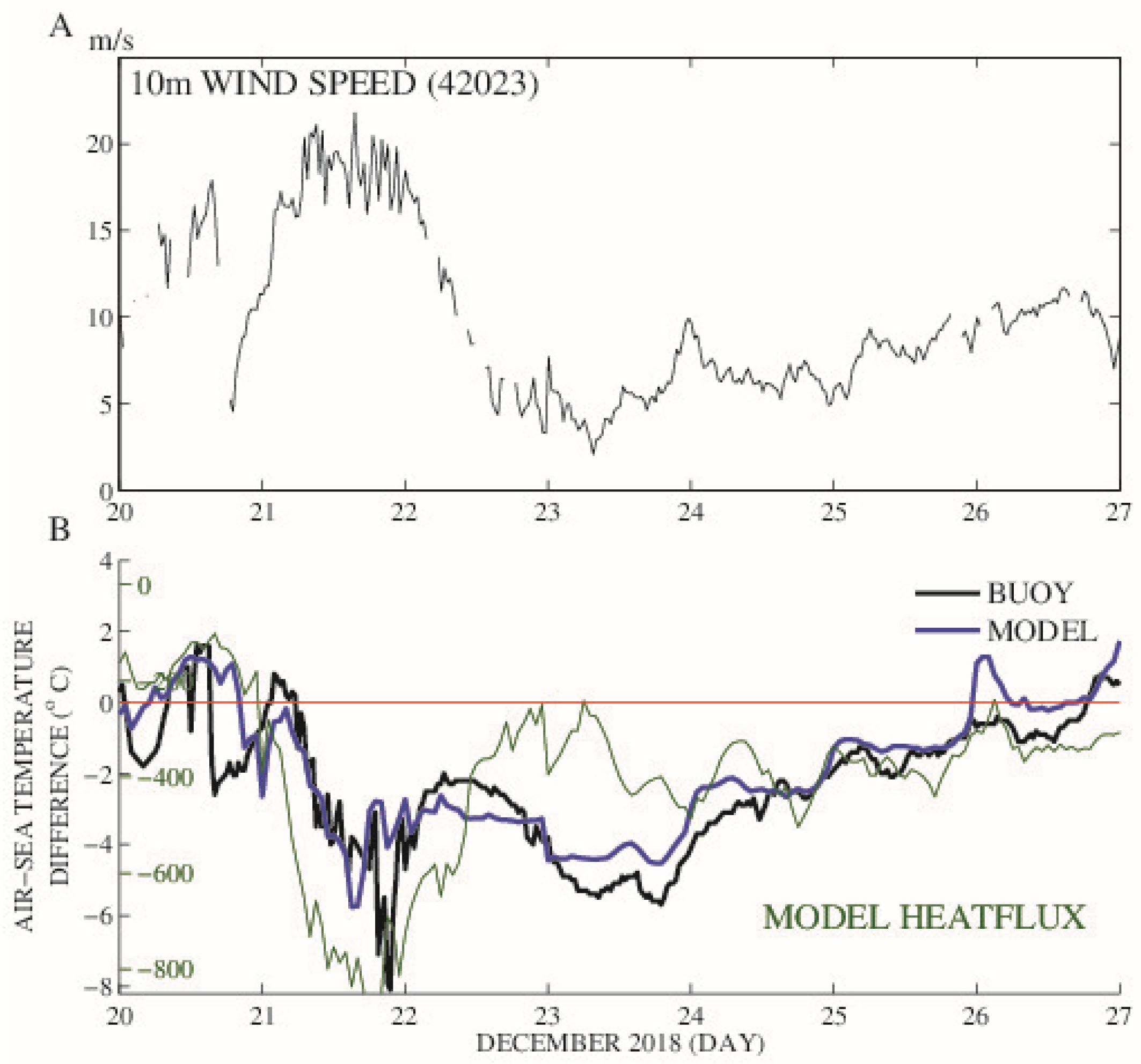
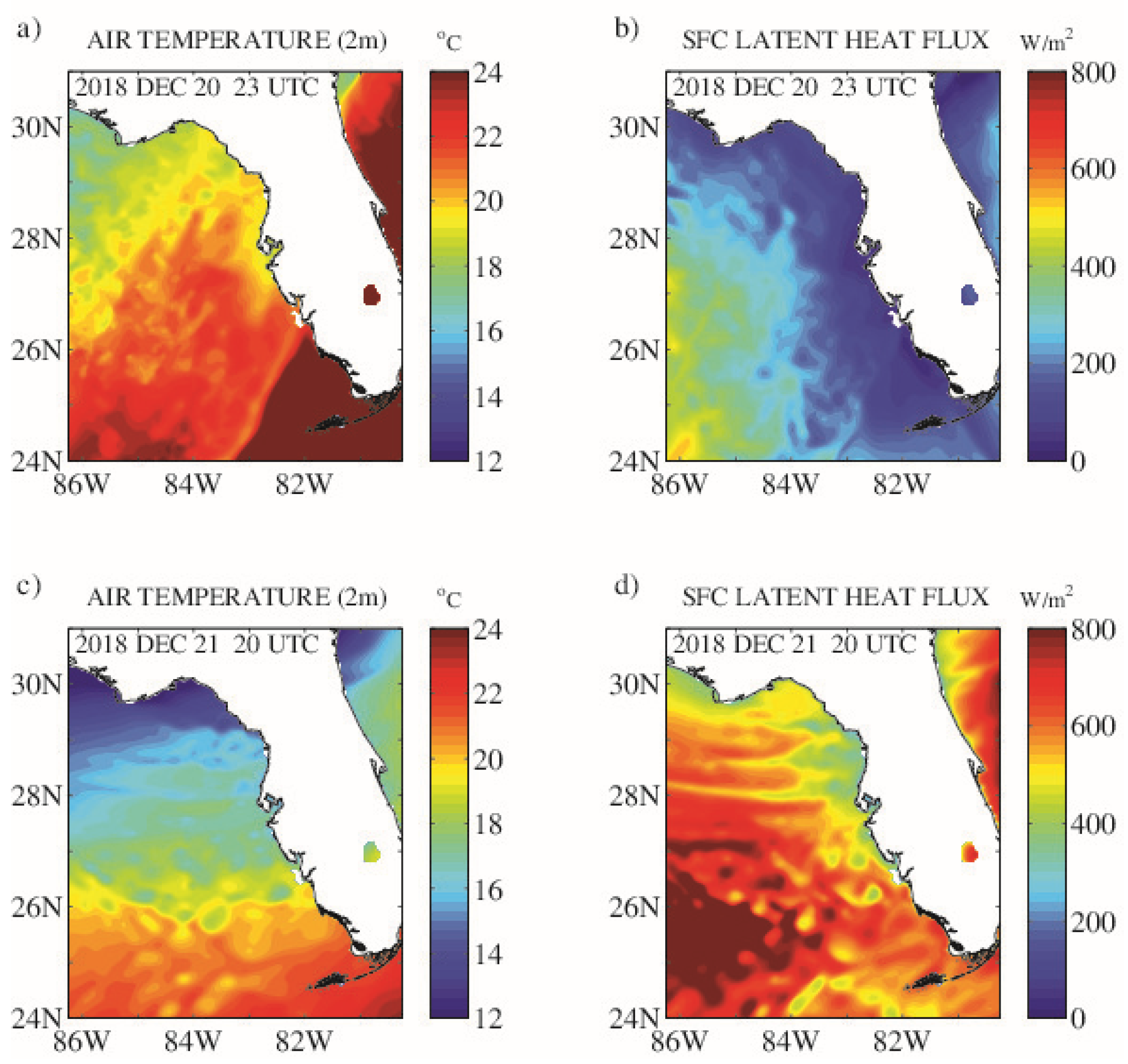
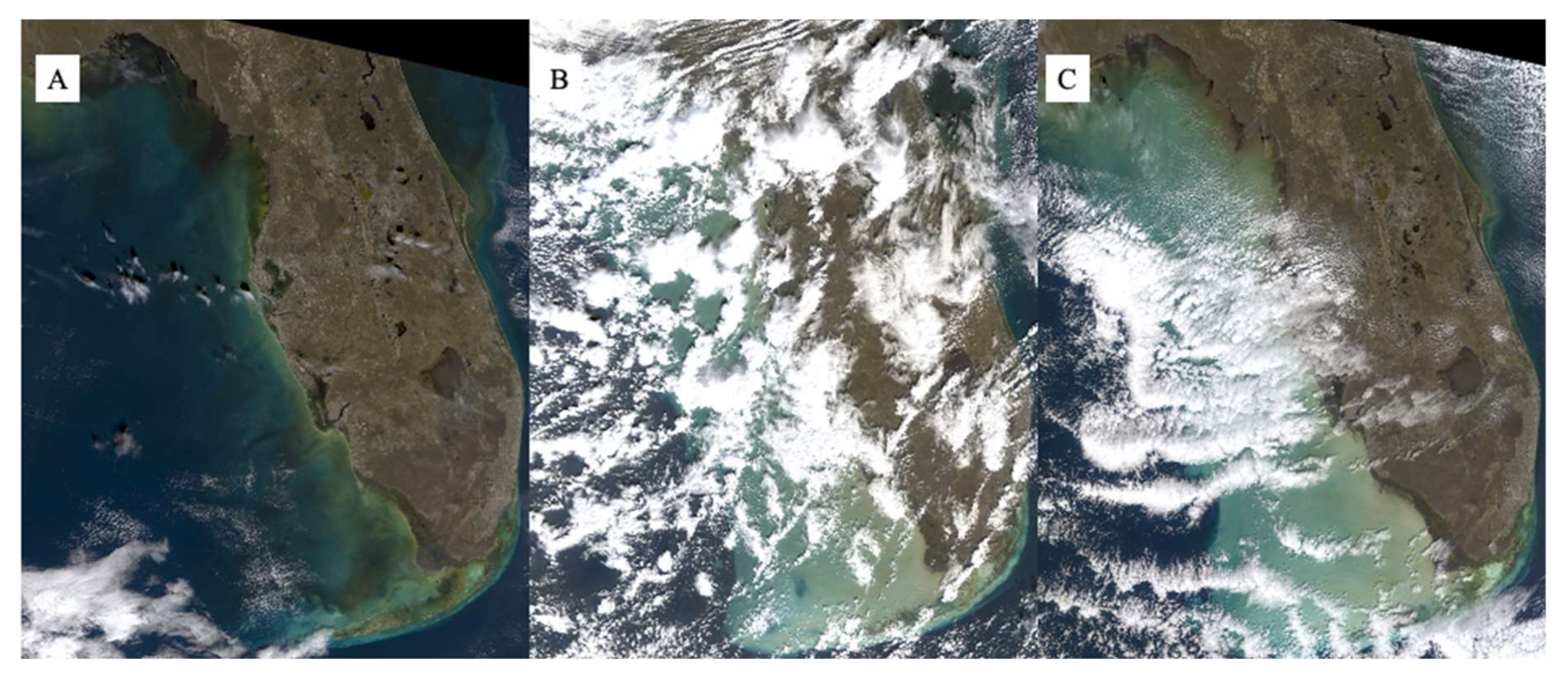

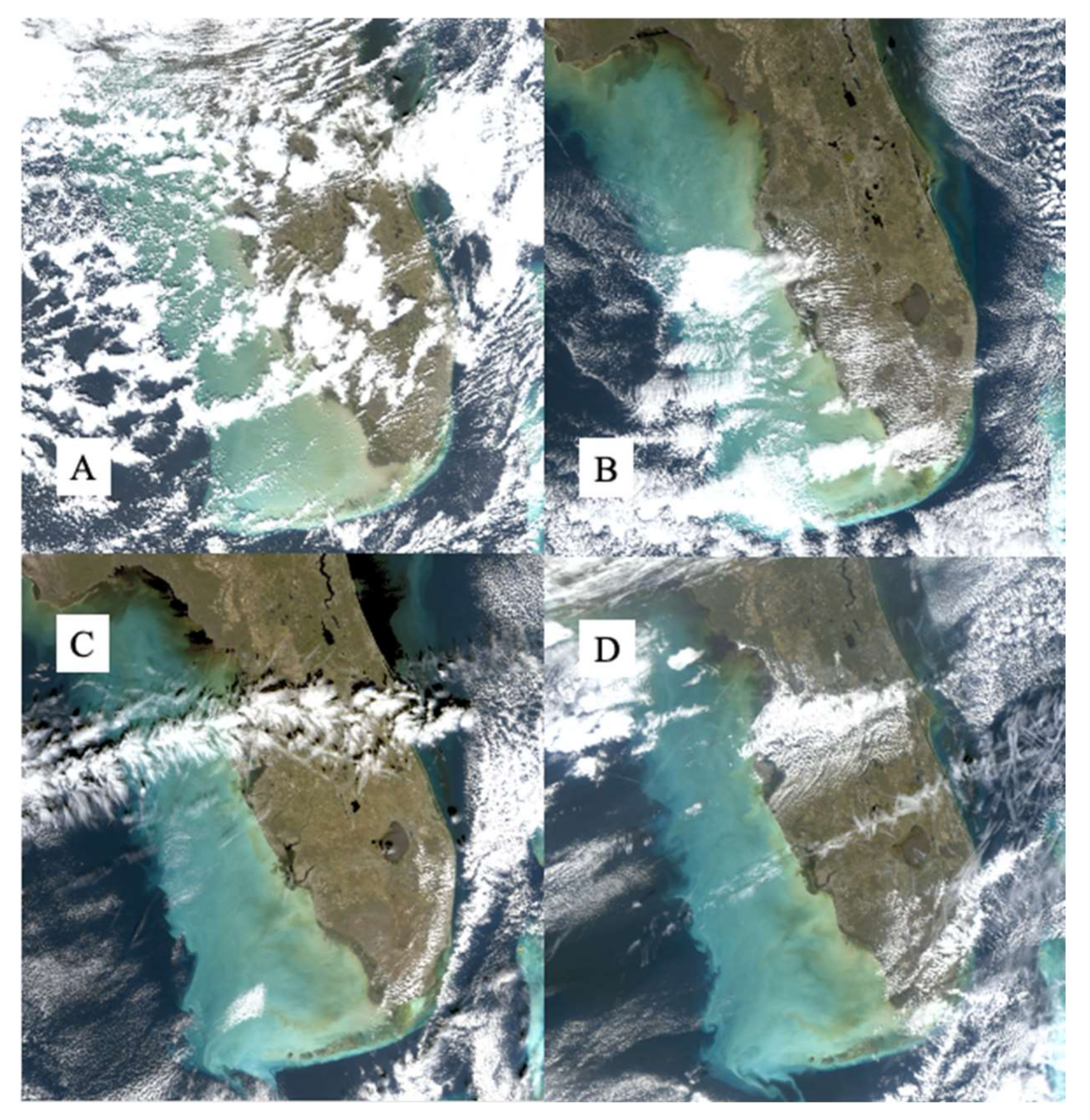
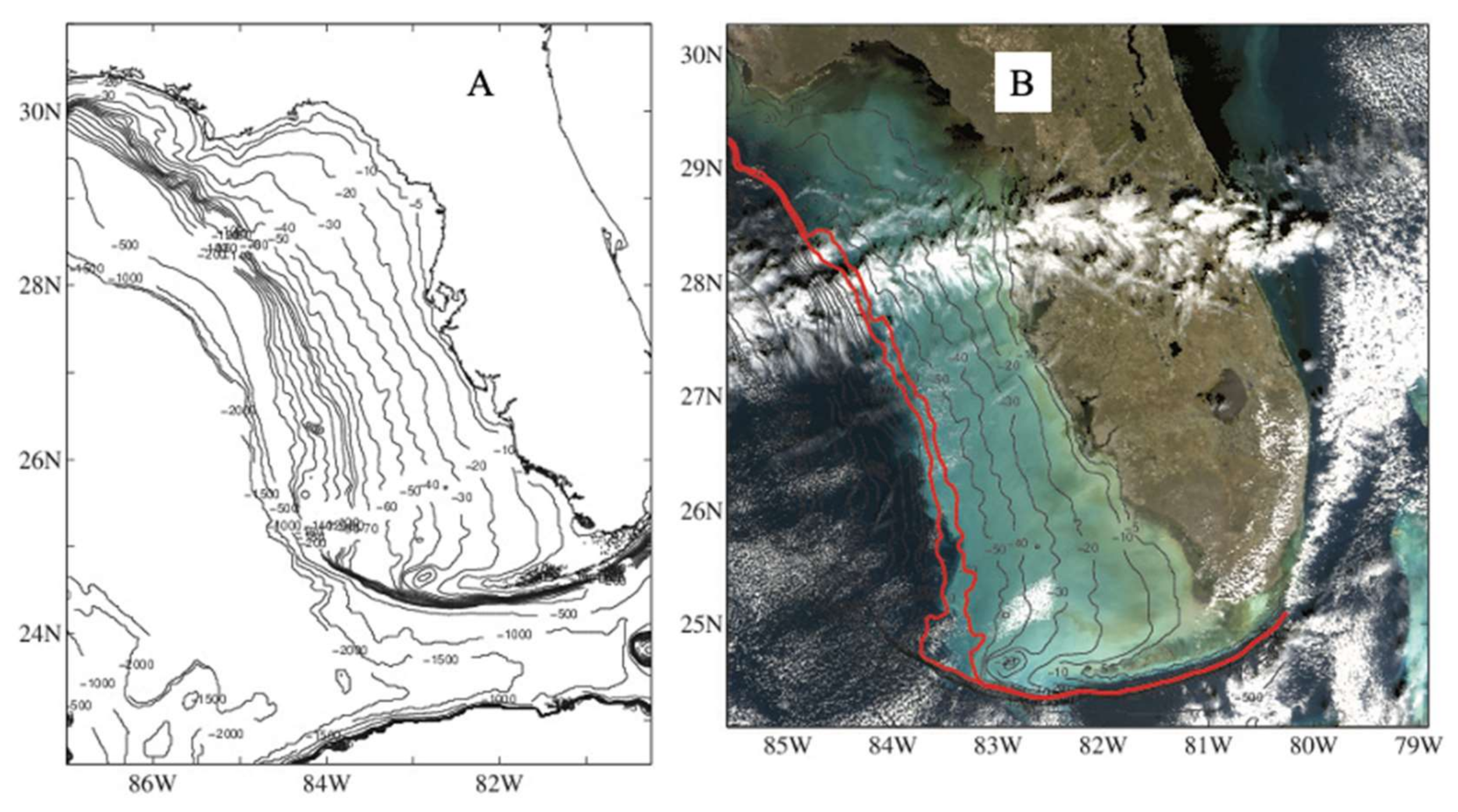
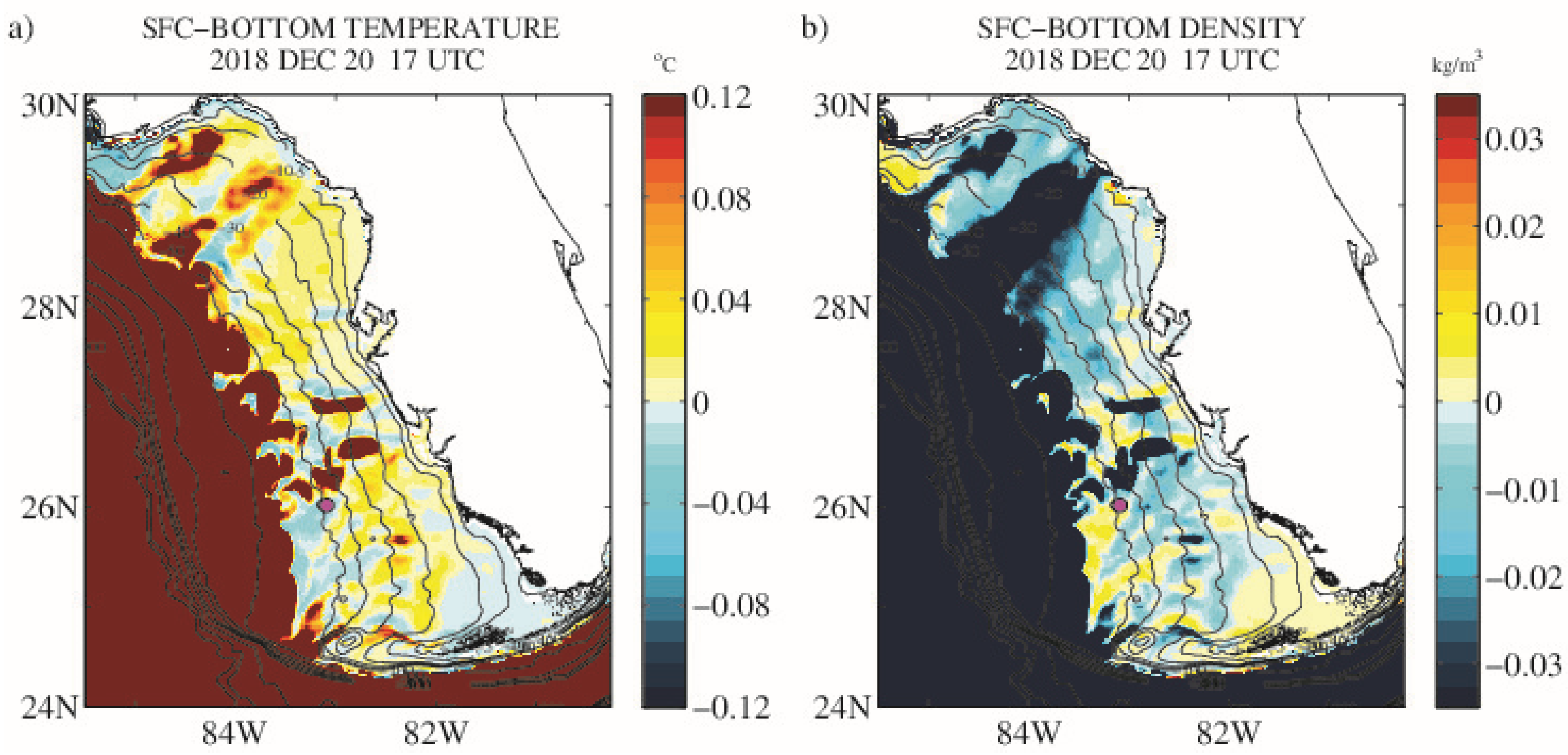
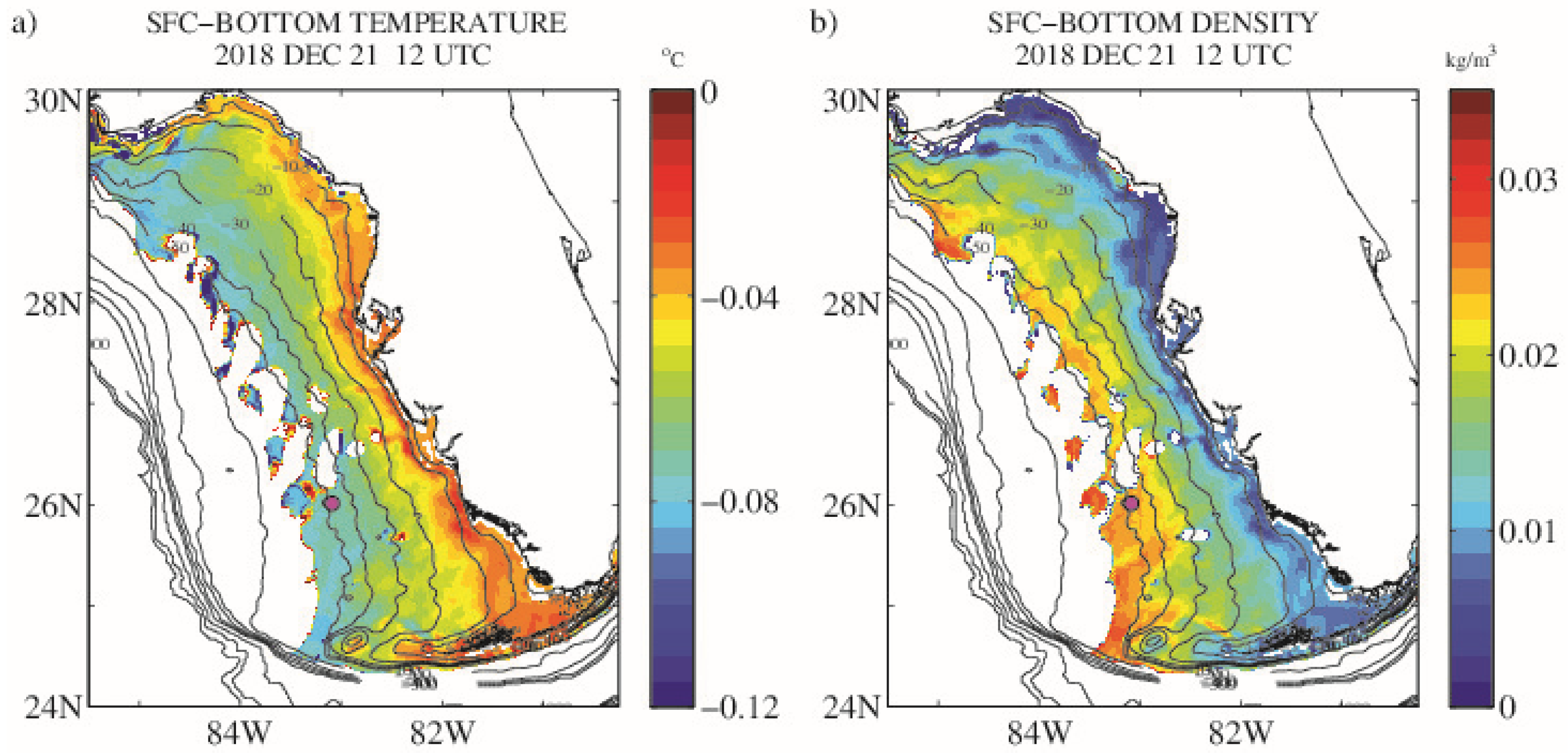







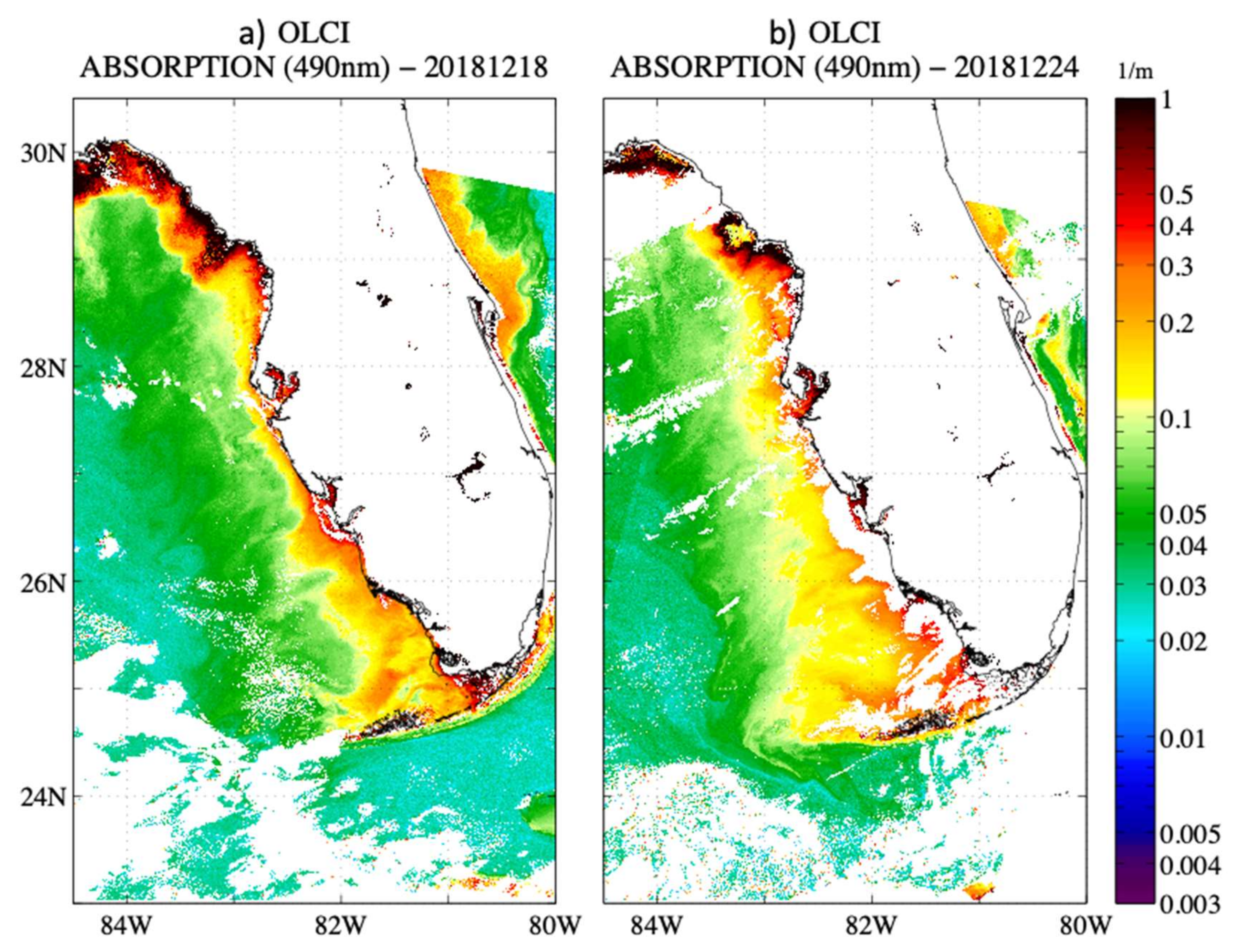
Publisher’s Note: MDPI stays neutral with regard to jurisdictional claims in published maps and institutional affiliations. |
© 2021 by the authors. Licensee MDPI, Basel, Switzerland. This article is an open access article distributed under the terms and conditions of the Creative Commons Attribution (CC BY) license (http://creativecommons.org/licenses/by/4.0/).
Share and Cite
Jolliff, J.K.; Ladner, S.; Smith, T.A.; Anderson, S.; Lewis, M.D.; McCarthy, S.C.; Crout, R.L.; Jarosz, E.; Lawson, A. On the Potential Optical Signature of Convective Turbulence over the West Florida Shelf. Remote Sens. 2021, 13, 619. https://doi.org/10.3390/rs13040619
Jolliff JK, Ladner S, Smith TA, Anderson S, Lewis MD, McCarthy SC, Crout RL, Jarosz E, Lawson A. On the Potential Optical Signature of Convective Turbulence over the West Florida Shelf. Remote Sensing. 2021; 13(4):619. https://doi.org/10.3390/rs13040619
Chicago/Turabian StyleJolliff, Jason K., Sherwin Ladner, Travis A. Smith, Stephanie Anderson, Mark David Lewis, Sean C. McCarthy, Richard L. Crout, Ewa Jarosz, and Adam Lawson. 2021. "On the Potential Optical Signature of Convective Turbulence over the West Florida Shelf" Remote Sensing 13, no. 4: 619. https://doi.org/10.3390/rs13040619
APA StyleJolliff, J. K., Ladner, S., Smith, T. A., Anderson, S., Lewis, M. D., McCarthy, S. C., Crout, R. L., Jarosz, E., & Lawson, A. (2021). On the Potential Optical Signature of Convective Turbulence over the West Florida Shelf. Remote Sensing, 13(4), 619. https://doi.org/10.3390/rs13040619






